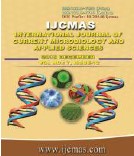


 National Academy of Agricultural Sciences (NAAS)
National Academy of Agricultural Sciences (NAAS)

|
PRINT ISSN : 2319-7692
Online ISSN : 2319-7706 Issues : 12 per year Publisher : Excellent Publishers Email : editorijcmas@gmail.com / submit@ijcmas.com Editor-in-chief: Dr.M.Prakash Index Copernicus ICV 2018: 95.39 NAAS RATING 2020: 5.38 |
The present study was conducted during 2013-14 n Karnataka state both n Northern (Dharwad) and Southern (Tumkur) districts of Karnataka. This study was conducted mainly to assess the scenario of Sthree Shakthi Self Help Groups as well as members in the study areas. It was observed from the study that more than eighty percent of the Dharwad and seventy percent of Tumkur women members have joined Sthree Shakthi Self Help Groups to sport family income and to attain financial security respectively. Among Dharwad respondents, agriculture (77%) was found to be the main reason for availing the loan from Sthree Shakthi Self Help Groups followed by animal husbandry (48.16%). Similarly in Tumkur district, agriculture (78.33%) was the main reason followed by income generation activities (54.44%) for loan availment. Thus, SSGs from both the selected districts were found to be on par with respect to performance even with varied sample size but, Z-values of the table indicated that they differ significantly for microenterprise development and for total at five percent level. The greater percentage of groups were categorized as good in case of Dharwad (66.70%) and very good in Tumkur (66.67%) districts.
 |
 |
 |
 |
 |